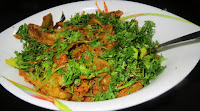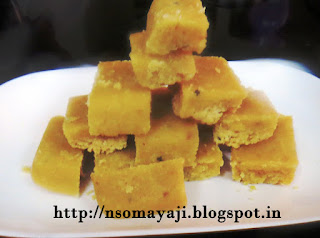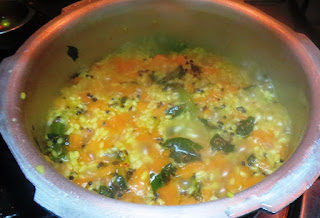Chutney Powder stuffed brinjal is a side dish and it goes well with all the main dishes. We do prepare different types of chutney powder which is used as one of the side dish mostly in South India. Chutney powders are protein rich content and served with dosa, idli, plain rice and chapatis or rotis. It is one of the traditional side dish I can say. I have used chutney powder which is prepared with flax seeds and ground nuts and stuffed it inside brinjal. Stuffed Brinjal is popular dish of North Canara, but it has become more popular in the whole world. People do love to have this stuffed brinjal with rotis, chapatis, pooris, millet rotis.
Lets see some benefits of having Ground Nuts in our diet.
Groundnuts said to be poor man's Almond.Ground nuts are also called as peanuts or monkey nuts. They contain good amount of mono saturated and polyunsaturated fats and it helps to keep our heart healthy. They also help in lowering blood cholesterol levels. They contain high amount of antioxidants. Peanuts have high amount of protein and it is good for vegetarians. They are rich in minerals like magnesium, phosphorus, potassium, zinc, calcium and sodium etc. They contain good amount of vitamins and dietary fiber.
Always remember that Eating excessive peanuts may lead to gas, heartburn and food allergy to peanuts.
There are different varieties of brinjals / Egg Plants in the market. I have used small size and tender brinjals.
Lets see the recipe Now:
Small Brinjals : 4 to 5 or more
Flax Seeds Chutney Powder : 1 Tablespoon
Coconut Chutney Powder : 2 Tablespoons
Groundnuts Chutney Powder : 2 Tablespoons
Rasam/Sambar Powder : 1 Tablespoon
Methi seeds : 1/2 Teaspoon
Tamarind pulp : 1 Tablespoon
Jaggery : 2 Tablespoon (Optional)
Seasoning :
Mustard seeds : 1 Teaspoon
Jeera : 1 Teaspoon
Oil : 1 Tablespoon
Ingh : a pinch
Curry leaves : Handful
Salt :As required
2. Take a big plate, add flax seeds chutney powder, coconut chutney powder, rasam powder and groundnuts chutney powder. Add salt. Mix it well. Stuffing is ready now.
3. Put a small portion (Slightly bigger than marble size) in hot water and squeeze out the pulp.
4. Now remove all the brinjals from water. Keep it on a plate.
5. Take one brinjal and fill mixed chutney powders in side the brinjal tightly. Repeat the same with rest of the brinjals and arrange it on a plate.
6. Keep a pan or pressure cooker on the fire. Add oil and mustard seeds. Let it splutter. Now add jeera and ingh. Add curry leaves. Let it be on low flame now.
7. Arrange all the brinjals one by one inside the pan. Sprinkle tamarind pulp.
8. Add little salt and remaining mixed powders and slowly stir it. Add methi seeds. Add 1/4 cup of water and close the lid.
9. Let it cook on medium flame. If you are cooking in pressure cooker use weight on the cooker and cook for 2 to 3 minutes.
10 . Let it cool. Remove the lid and check the brinjals. Remove from the cooker or pan to a serving dish.
11. Add coriander leaves on the top.
12. Serve with the main dish you have prepared.
Time : 15 minutes.
Servings : 3 to 4.
Link to prepare Chutney Powder :
http://nsomayaji.blogspot.in/2016/02/flax-seeds-chutney-powder.html
Lets see some benefits of having Ground Nuts in our diet.
Groundnuts said to be poor man's Almond.Ground nuts are also called as peanuts or monkey nuts. They contain good amount of mono saturated and polyunsaturated fats and it helps to keep our heart healthy. They also help in lowering blood cholesterol levels. They contain high amount of antioxidants. Peanuts have high amount of protein and it is good for vegetarians. They are rich in minerals like magnesium, phosphorus, potassium, zinc, calcium and sodium etc. They contain good amount of vitamins and dietary fiber.
Always remember that Eating excessive peanuts may lead to gas, heartburn and food allergy to peanuts.
There are different varieties of brinjals / Egg Plants in the market. I have used small size and tender brinjals.
Lets see the recipe Now:
Things Needed :
To Cook :Small Brinjals : 4 to 5 or more
Flax Seeds Chutney Powder : 1 Tablespoon
Coconut Chutney Powder : 2 Tablespoons
Groundnuts Chutney Powder : 2 Tablespoons
Rasam/Sambar Powder : 1 Tablespoon
Methi seeds : 1/2 Teaspoon
Tamarind pulp : 1 Tablespoon
Jaggery : 2 Tablespoon (Optional)
Seasoning :
Mustard seeds : 1 Teaspoon
Jeera : 1 Teaspoon
Oil : 1 Tablespoon
Ingh : a pinch
Curry leaves : Handful
Salt :As required
Method :
1. Wash and cut brinjals till the edge. Do not cut it fully. Dip in water and let it be there for 10 minutes.2. Take a big plate, add flax seeds chutney powder, coconut chutney powder, rasam powder and groundnuts chutney powder. Add salt. Mix it well. Stuffing is ready now.
3. Put a small portion (Slightly bigger than marble size) in hot water and squeeze out the pulp.
4. Now remove all the brinjals from water. Keep it on a plate.
5. Take one brinjal and fill mixed chutney powders in side the brinjal tightly. Repeat the same with rest of the brinjals and arrange it on a plate.
6. Keep a pan or pressure cooker on the fire. Add oil and mustard seeds. Let it splutter. Now add jeera and ingh. Add curry leaves. Let it be on low flame now.
7. Arrange all the brinjals one by one inside the pan. Sprinkle tamarind pulp.
8. Add little salt and remaining mixed powders and slowly stir it. Add methi seeds. Add 1/4 cup of water and close the lid.
9. Let it cook on medium flame. If you are cooking in pressure cooker use weight on the cooker and cook for 2 to 3 minutes.
10 . Let it cool. Remove the lid and check the brinjals. Remove from the cooker or pan to a serving dish.
11. Add coriander leaves on the top.
12. Serve with the main dish you have prepared.
Note :
If the brinjals are not cooked properly, just add little water and cook on medium flame. Adding more or less masla is optional. No need to add more coconut. Chutney powders contain coconuts. Adding garam masala with all the powders is optional. It adds to the aroma of brinjal stuffed curry. If pressure cooked brinjals turns watery, you just put the curry in a big pan and cook on high flame. All the moisture disappears. The curry should be thick. Use of pressure cooker helps to use less oil. Do not over cook and do not use more water. Just 1/4 cup of water is more than enough. Use of jaggery is optional. I have not used.Time : 15 minutes.
Servings : 3 to 4.
Link to prepare Chutney Powder :
http://nsomayaji.blogspot.in/2016/02/flax-seeds-chutney-powder.html


















































